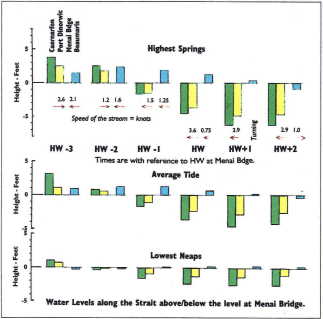2.
flood stream in the Strait has been running that way anyway, so there's no clear distinction between the flood and ebb streams. But to add further confusion, in the Strait it's the local practice to call all of the southwest-going stream 'The Ebb', even though the first hour and a half of it is actually the second phase of the flood. This gives rise to the apparently unique phenomena, that unlike anywhere else in the World, in the Menai Strait not only does the tide rise strongly right throughout the period they call 'The Slack', but even after the direction of the stream has reversed it goes on rising strongly for the first hour and a half of 'The Ebb'. Captain Goddard (ship's first term at Plas Newydd): "We were highly amused by the antics of the tide" (Masefield)
3. Menai Straits Tides in greater detail.
But the streams in the Menai Strait are not tidal streams, but are instead a response to differences in the water levels which result from the frictional stress on the tide induced by the physically restrictive environment. Thus although not tidal streams, the differences in water levels which promote the flow are themselves the product of the tide, thus drawing the distinction between tidal streams and tide generated streams such as occur in the Menai Strait. The two locations in the Strait with the greatest frictional resistance are its narrow and shallow southwestern entrance at its one end, Anglesey Pilot p_20 and the tortuous rock-bound Swellies near its other. These limit the water entering the Strait when the Irish Sea is flooding, leaving the water level in the Strait lagging behind sea level in the second half of the flood, and conversely, since water cannot exit the Strait quickly enough to keep pace with the falling tide outside, the water level in the Strait remains above sea level during the latter half of the ebb. Thus not only are there times during the tidal cycle when the water flows right the way through the Strait one way or the other
| other as one might naturally expect, but there are other times when in response to the water level in the Strait being either higher or lower than sea level at its ends the water flows either into the Strait or out of it through both its entrances at once. This effect is best appreciated by studying the excellent page of hourly chartlets published by the Royal Welsh Yacht Club (RWYC) under the title : Menai Straits Tides at a Glance, which if studied in conjunction with the Marine Science Lab's Mean Spring Tidal Conditions in the Menai Strait will give clear insight into the causes of the varying directions of the stream during a typical semi-diurnal tidal cycle |
|
Fig.1
|
